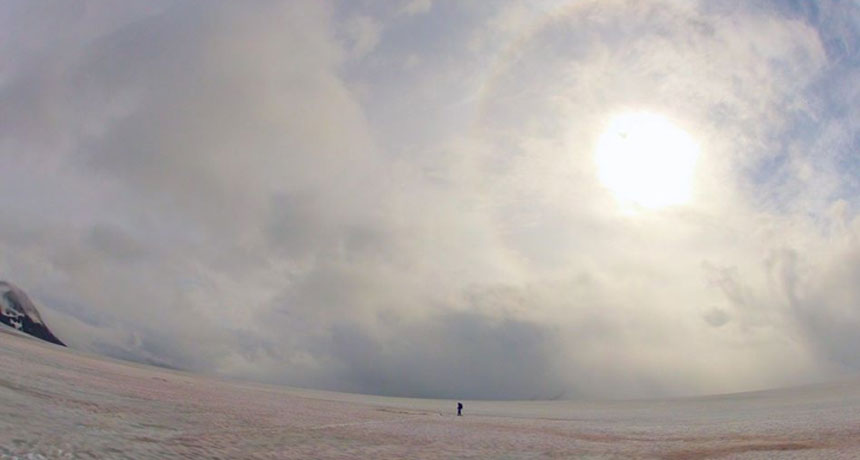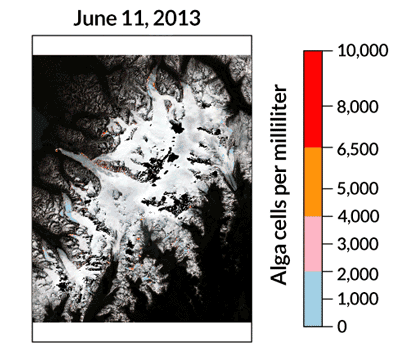‘Watermelon’ snow is helping melt glaciers
Algae that paint the snow pink make it absorb more sunlight — and heat

Some Arctic algae turn the snow red to pink on parts of Alaska’s Harding Icefield. This colored snow melts faster than clean, white snow, new data show.
Gerard Ganey
Certain microbes that grow on glaciers and ice sheets can paint the snow pink. Sometimes called watermelon snow, this reddish pigment makes the snow soak up more sunlight. And that makes it melt faster, data now show.
The alga Chlamydomonas nivalis (KLAM-ee-duh-MO-nus NIV-ah-lis) and its kin appear to be to blame. C. nivalis thrives in cold water. Although frozen, glaciers and snow are still watery environments, says Roman Dial. He’s a biologist at Alaska Pacific University in Anchorage. He also was an author of the new study.
These watermelon-hued algae appear in the spring and summer. At times they will proliferate dramatically. Ecologists refer to this as an algal bloom. Research had suggested a colorful blood could darken snow, fostering its melt. The reason: Dark colors absorb more sunlight. That’s why you feel hotter standing in the sun in a black shirt than in a white one. A bloom of C. nivalis is like covering snow with a dark t-shirt.
If microbes help melt the snow, that water might help even more algae grow. That could create a “feedback” cycle where increased melting creates conditions for even more melting. Or that’s what scientists suspected. But to be sure, they need to acquire some data from testing.
“We used everything from microscopes to satellites,” Dial says. Doing so confirmed that places with extra watermelon algae melted much faster.
The researchers shared their new data September 18 in Nature Geoscience.
Little microbes, big effect
Glaciers naturally have small amounts of nutrients. These include nitrogen and phosphorus. Higher levels of those nutrients might act as fertilizer to help algae grow. So Dial and colleagues added either plain water or water with fertilizer in it to different patches of snow on Harding Icefield. This frozen expanse in southern Alaska spans 1,900 square kilometers (730 square miles).

In places where they added water, 50 percent more algae grew than in untouched areas. Adding fertilizer quadrupled the algal growth.
Now that the scientists knew how to boost algae growth, they did related tests. In some areas, they boosted the growth of the algae by dousing the snow in fertilizer. At other sites, they killed off such algae with bleach. Over 100 days, the scientists tracked melting at both sites.
Places with extra algae melted much faster than where the algae were wiped out. By the end of the test, snow that got extra algae was three times as likely to have melted to slush or down to a layer of ice beneath it. Exposing that ice under the snow could further boost algae’s melting. Why? Bare ice absorbs more sunlight than does clean snow.
The team collected satellite data, such as photos of the snow cover and measurements of how reflective the snow was. From this, the team then estimated the effects of algae across the whole Harding Icefield.
Algae grew on more than one-third of the ice sheet. Within that area, the microbes were responsible for almost one-sixth of the snowmelt, the team calculated. Warm temperatures caused most of the rest of the melt.
Not just Alaska
“There’s a growing push to understand the impact of microorganisms on glaciers and ice sheets,” says Christopher Williamson. He’s a microbiologist in England at the University of Bristol who did not take part of this study. Scientists often do research like this — observing one area over a long time, Williamson says. But here, scientists instead altered the environment to probe directly for any direct link between algae and snowmelt.
The effect probably isn’t limited to Alaska, either. Another team sampled watermelon snow across the Arctic. They found that the reddish snow was 13 percent less reflective. And any light that is not reflected into space can be absorbed by the snow as heat. So the snow probably melted faster, although the scientists didn’t measure that directly.
Those researchers published their results last year in Nature Communications.
C. nivalis and other snow microbes like to live where the temps are just below freezing. If global warming heats up more of the Arctic into this range, those algae might expand their range.
Other microbes or pollutants might also speed the melting of Arctic ice. Williamson is part of a five-year project studying the impact of microbes on ice in Greenland. There, he’s studying both bacteria and ice algae — which are different than snow algae. These microbes have been darkening Greenland’s ice. That may help explain why ice there has been melting faster than would be expected due to climate change alone. Williamson and colleagues now want to figure investigate if microbes are part of the reason.







